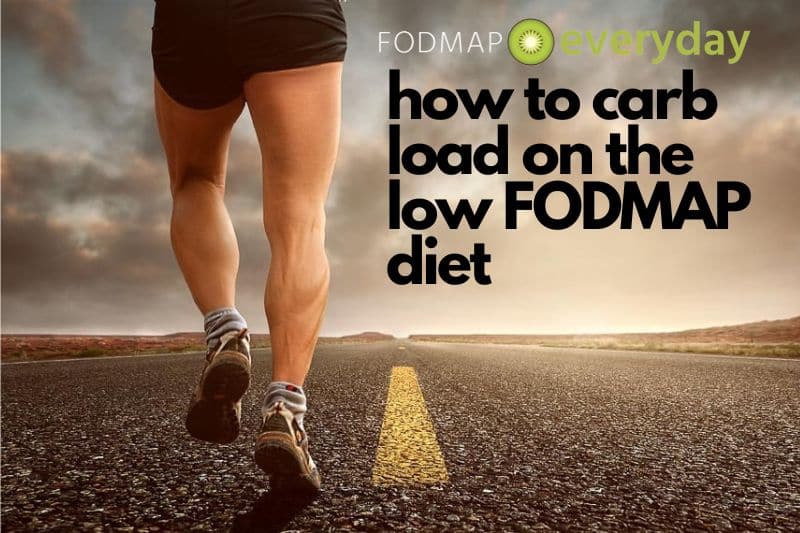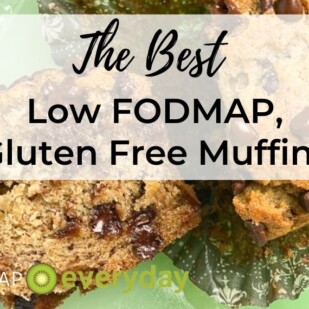How to Carb Load On the Low FODMAP Diet
Did you know that carb loading before a marathon or another type of endurance sporting event can help you improve your performance? And yes, it is possible to carb load and feel great even if you have IBS! Here is how to carb load on the low FODMAP diet.

Building Up Glycogen Stores
During a long distance race (90 minutes or longer) such as a marathon, a triathlon, or another endurance sporting event, the body uses glycogen (carbohydrate) stores as its main source of fuel. When glycogen stores in the muscle and the liver become depleted, the body then needs to rely on fat to produce energy.
Fat is a less effective fuel than glycogen, because it requires a lot more oxygen to produce the same amount of energy.
Therefore, the sooner you run out of glycogen, the sooner you will feel tired and will have to slow down. Carb loading a few days before a marathon or an endurance event can help optimize performance. It consists of modifying your diet and training to maximize the amount of glycogen in your muscles.
A proper protocol followed faithfully will nearly double your muscle’s glycogen content! It is estimated that carbohydrate loading can improve performance over a set distance by 2 to 3%.
 How to Carb Load On the Low FODMAP Diet – and Not Trigger IBS
How to Carb Load On the Low FODMAP Diet – and Not Trigger IBS
According to the most recent research, it is recommended to reduce training volume the days before the race (what’s known as tapering) and adopt a carbohydrate rich diet (7g to 12g of carbohydrates per kilogram of body weight) for three days before the race. Now that’s a lot of carbs! It’s about 70 to 80% of your calories as carbohydrates.
This can be challenging if you are following a low FODMAP diet and there are a lot of carbohydrate rich foods that trigger your GI symptoms.
Here are 5 tips to help you succeed:
1) Stick to foods that you can tolerate very well
Identify the carbohydrate rich foods that you know you tolerate very well and stick to those foods as much as possible. Even if that means eating the same foods a few times, it’s only for 3 days… Better be safe than sorry!
2) Don’t overeat!
Understand that you do not need to eat more than usual. Eating too much will make you feel full and sluggish. Instead, you need to substitute fat and protein with carbohydrate. For example, if you usually put some avocado in your salad, put some blueberries instead. If you usually snack on almonds, snack on rice crackers instead.
If you usually eat eggs for breakfast, eat oatmeal or gluten free waffles with maple syrup instead. You need to modify your food choices, not the serving sizes! Eat smaller meals and snacks more often – at least 6 times per day – to avoid feeling too full. Make sure to stick to low-fat foods.
3) Plan your carb loading ahead of time
Plan your carb loading ahead of time to avoid being caught off guard.If you need to travel for your race, make sure to bring high carbohydrate low FODMAP snacks with you such as rice cakes, rice crackers, gluten free bagels, dried banana chips, bananas, instant oatmeal and low FODMAP cereal such as Cheerios or Chex.
4) Drink some of your carbs
During carb loading, carbohydrate needs are so high, which makes it hard to meet your needs with solid foods without feeling too full. That is why drinking some of your carbs is a good idea! Choose a sweet drink that you can tolerate well, such as the one that you usually drink during a long workout.
Gatorade is usually well tolerated by people that have IBS. You can also drink cranberry juice, which is low FODMAP, or again you can try our strawberry lemonade.
5) Do not try something new on race day
The morning of the race, eat what you are used to eating before exercising. You should test different breakfasts options in advance so you can find a breakfast that you can tolerate well.
You should also carry your own supplements such as gels and sports drinks or make sure that you are familiar with the ones that are provided on the race course.
Here is a low FODMAP carb loading one-day meal plan to guide you*:
*The menu is based on a 3000-calorie diet. Serving sizes should be adjusted according to one’s individual energy needs. Don’t hesitate to consult a Sports Dietitian to get a personalized meal plan.
Breakfast:
- 3 gluten free waffles or pancakes, 4 inches (10 cm) diameter each (made with gluten free flour and lactose free milk)
- 2 tablespoons of blueberry compote or 1 tablespoon maple syrup and ¼ cup (64 g) blueberries
- 1 orange
- 1 cup coffee with 2 teaspoons sugar
AM Snack:
- 15 dried banana chips or 1 banana or 1 slice of banana bread
- ½ cup (125g) lactose free low fat strawberry yogurt
- 1 cup (250 ml) Gatorade
Lunch:
- ½ cup dry (100g) rice (1½ cup cooked)
- 2 oz (60g) baked chicken
- ½ cup (100g) green beans
- 1 cup (250 ml) cranberry juice or strawberry lemonade
PM Snack
- 3 rice cakes with 2 tablespoons (30 ml) orange marmalade or strawberry jam
- 1 cup (150g) grapes
- 1 cup (250 ml) Gatorade
Supper
- 1 ½ cup (150g) gluten free pasta
- 1 cup (250 ml) tomato sauce
- 1 cup (240 ml) of cranberry juice or strawberry lemonade
- ½ packet (240 ml) lime Jello
Evening Snack
- ½ cup (60g) low FODMAP granola or 1 serving of strawberry rhubarb crisp
- ¾ cup (200 ml) rice milk
References
- Monash University. Low FODMAP smartphone app. Retrieved from Monash.edu.au
- Jeukendrup (2016) Carb Loading: What is New?
- Atkinson et al. (2011) Pre-Race Dietary Carbohydrate Intake can Independently Influence Sub-Elite Marathon Running Performance. Int J Sports Med; 32: 611– 617.
- Australian Institute of Sports (2004) Carbohydrate Loading.
 How to Carb Load On the Low FODMAP Diet – and Not Trigger IBS
How to Carb Load On the Low FODMAP Diet – and Not Trigger IBS







I am a marathon runner in Canada and I can’t find a low FODMAP gel for the life of me. Do you know of any low FODMAP brands I could try?
Hi Amy,
I would suggest that you try the clif shot energy gels citrus or vanilla flavor, they both contain maltodextrin and dry cane syrup as their main ingredients and are usually well tolerated by endurance athletes that have IBS. Note that the citrus flavored one has caffeine (25mg), it is a low dose, but caffeine can sometimes cause diarrhea in people that have IBS. If you are used to drinking coffee or consuming other products that contain caffeine you should have no problem. I would avoid any gels that contain fructose, honey or fruit purees. I also like Brix gels, they are made of 100% maple syrup and are low FODMAP. They are sold mainly in the provinces of Quebec and Ontario, but you can also purchase them online: http://en.brixalerable.ca/energy-products-with-natural-maple-syrup/ I hope that helps, let me know if you have other questions!
Hi there. I’ve been on the fodmap diet for 6 weeks. I’m a keen runner/triathlete. I’m struggling to get enough fuel for workouts and have been loosing weight quickly. I can see the meal plan for carb loading. What weight athlete is that based for? I weigh about 96kg and I’m guessing that plan won’t be high enough for me. Before this diet I would maintain weight and have enough energy for races and training. And at the moment I’m struggling for a sensible plan. Thanks david
Hi there. I will reach out to Kathryn. Stay tuned. Thank you for writing!
Hi David,
Thanks for your comment. The meal plan is provided as an example and is not personalized to anyone. Yes I agree that based on your weight you need more carbs than this generic meal plan provides. You might benefit from adding more snacks to your diet, since with the low FODMAP diet your are restricted with portion sizes but you can eat the ”green” serving sizes several times per day. After 6 weeks on the low FODMAP diet you should be able to start the reintroduction trials to liberalize your diet. I would be glad to further help you and provide you with a personalized meal plan. Don’t hesitate to email me or message me via my website to schedule an appointment with me.